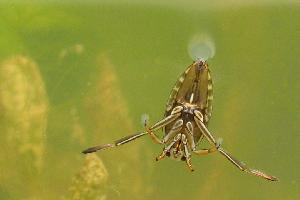
Descrierea animalului
The Common Backswimmer, scientifically known as Notonecta glauca, is a fascinating species of aquatic insect belonging to the family Notonectidae. This intriguing creature is primarily found in freshwater habitats across Europe and Asia, and it has garnered attention for its unique swimming behavior and striking appearance.One of the most notable characteristics of the Common Backswimmer is its mode of locomotion. Unlike most aquatic insects that swim with their belly down, the Common Backswimmer propels itself through the water belly-up, an unusual trait that has earned it its name. This peculiar behavior is facilitated by its specially adapted hind legs, which are long, oar-like, and fringed with hairs, acting as powerful paddles that allow it to move swiftly through the water. This distinctive swimming style not only makes the Common Backswimmer a proficient predator but also provides it with a quick escape mechanism from potential threats.
The appearance of Notonecta glauca is equally remarkable. Typically, the insect measures about 10 to 15 millimeters in length, with a sleek, streamlined body that is well-suited to its aquatic lifestyle. Its body is usually light brown to olive-green in color, providing excellent camouflage against the backdrop of pond vegetation and detritus. However, what truly sets the Common Backswimmer apart is its strikingly colored underside, which is often a silvery-white hue. This coloration is the result of tiny air bubbles trapped under its abdomen, which not only aids in buoyancy but also reflects light, making it appear as if it is shimmering underwater.
The diet of Notonecta glauca is as varied as its habitat, consisting primarily of small aquatic invertebrates, tadpoles, and even small fish. It is an ambush predator, using its camouflage and swift movements to sneak up on unsuspecting prey. Once within reach, it uses its sharp, piercing mouthparts to inject a lethal saliva that immobilizes its victim, making it easier to consume.
Reproduction in Common Backswimmers is an interesting process. During the mating season, males produce a unique chirping sound by rubbing their front legs against their head, a behavior known as stridulation, to attract females. After mating, females lay their eggs on aquatic plants, ensuring the next generation's survival.
Despite their somewhat daunting appearance and predatory nature, Common Backswimmers play a crucial role in their ecosystems. They help regulate populations of smaller aquatic organisms, preventing overpopulation and the potential depletion of resources. Moreover, they serve as a vital food source for a variety of fish and birds, thus contributing to the biodiversity and balance of freshwater ecosystems.
In summary, the Common Backswimmer, Notonecta glauca, is a remarkable insect that captivates the interest of scientists and nature enthusiasts alike. Its unique swimming behavior, striking appearance, and role in the ecosystem make it a fascinating subject of study and an important component of aquatic habitats.
Fotografii noi cu animale
Top 10 animale
- Dolphin gull (Leucophaeus scoresbii)
- Diana monkey (Cercopithecus diana)
- Moustached guenon (Cercopithecus cephus)
- Greek tortoise (Testudo graeca)
- Stone loach (Barbatula barbatula)
- Galápagos tortoise (Geochelone nigra complex)
- Japanese macaque (Macaca fuscata)
- Russian tortoise (Testudo horsfieldii)
- Common flying dragon (Draco volans)
- Galápagos penguin (Spheniscus mendiculus)